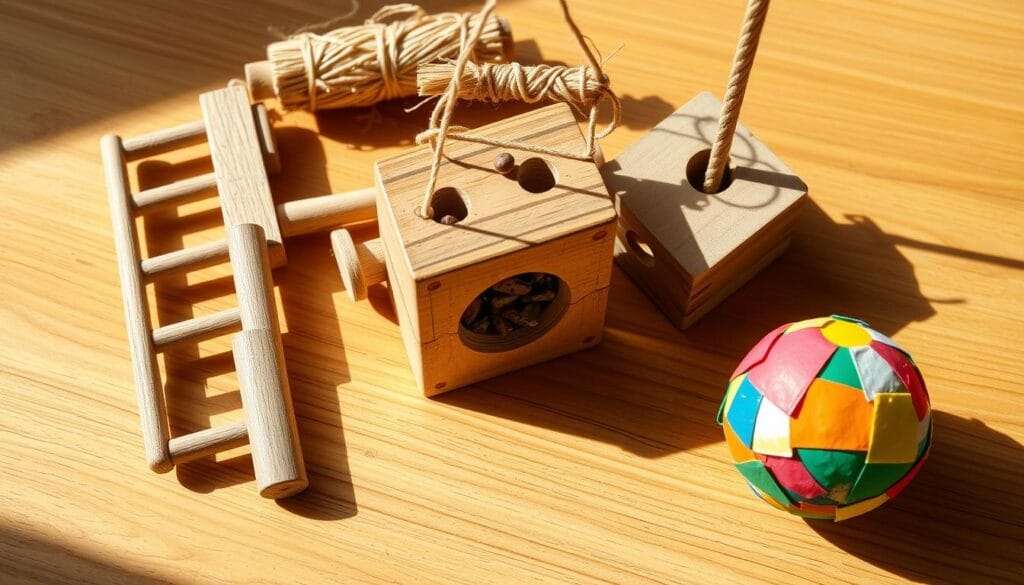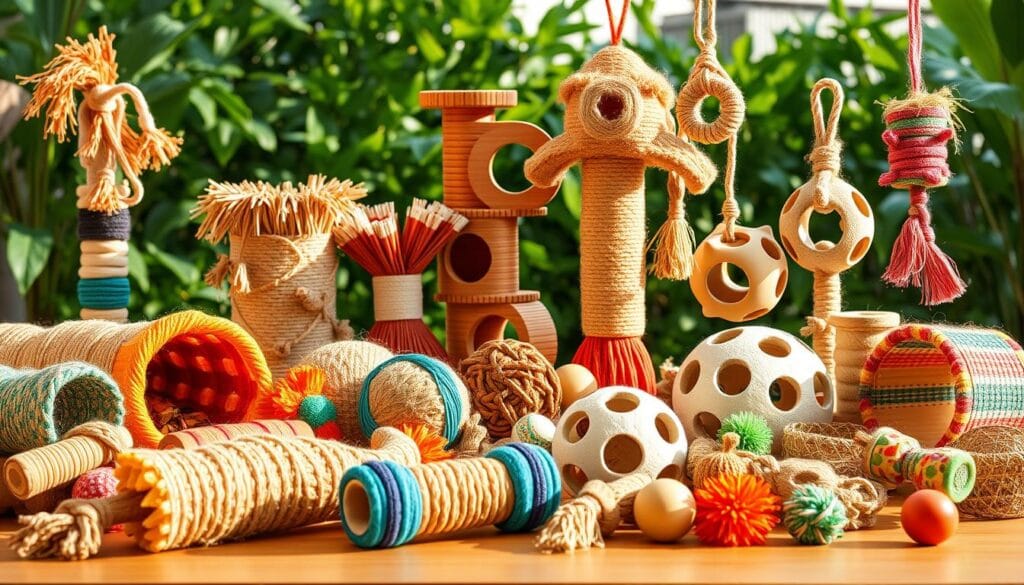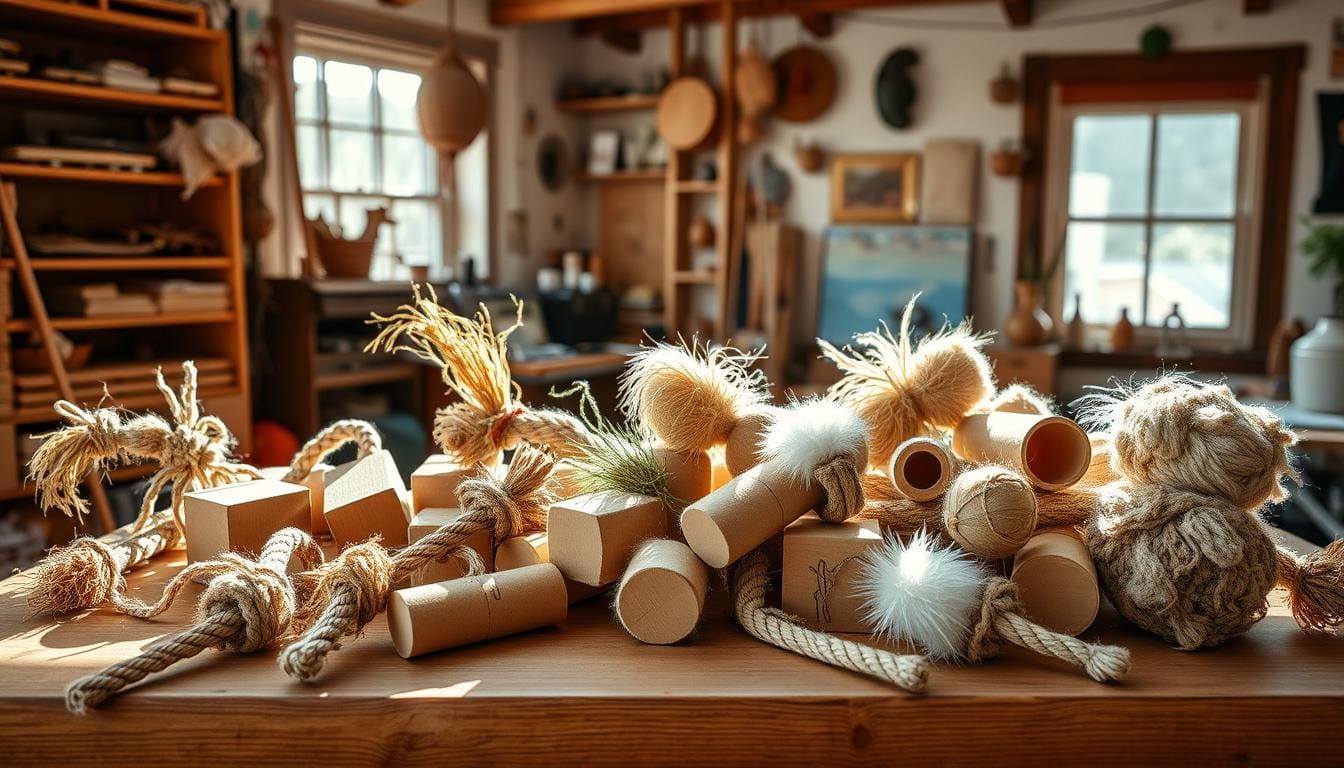As a pet owner, I’ve learned that keeping my unique animals happy is key. Many exotic animals get bored and stressed because they lack fun activities.
By making homemade pet toys, I give my pets the enrichment they crave. In this article, I’ll show you simple and cheap DIY pet enrichment ideas. These are perfect for different exotic pets, making their lives more exciting.
Table of Contents
Understanding the Importance of Enrichment for Exotic Pets
As exotic pet owners, we must understand the importance of creating an enriching environment. Enrichment is not just a luxury; it’s a necessity for our pets’ well-being. By providing a stimulating environment, we can prevent behavioral problems and ensure our pets live happy, healthy lives.
What is Pet Enrichment?
Pet enrichment stimulates our pets’ natural behaviors, encouraging them to engage in activities that promote physical and mental health. This includes toys, puzzles, and environmental changes to keep our pets engaged and stimulated. For exotic pets, enrichment is key as it mimics their natural habitats and behaviors, reducing stress and boredom.
Effective enrichment strategies vary by pet type. For example, birds may enjoy toys that challenge their problem-solving skills. Small mammals might need tunnel systems for hiding and seeking. To learn more about socialization techniques that complement enrichment, visit exotic pet socialization techniques.
Why Exotic Pets Need Mental Stimulation
Exotic pets, like all animals, need mental stimulation to prevent boredom and stress. Without it, they can develop behavioral problems, such as feather plucking in birds or excessive pacing in small mammals. Enrichment activities keep their minds active and engaged, promoting overall well-being.
Mental stimulation is also crucial for exotic pets’ cognitive health. It challenges their problem-solving abilities and keeps them curious about their environment. By adding a variety of enrichment activities to their daily routine, we can ensure our exotic pets stay mentally sharp and emotionally balanced.
Safe Materials for DIY Pet Toys
Choosing the right materials for DIY pet toys is key for your pet’s safety and fun. The materials you pick can affect your pet’s health and how long the toy lasts.
It’s important to know the differences between materials. Natural materials like wood, cotton, and untreated wicker are good because they’re non-toxic and can break down easily. But, synthetic materials might last longer but could have harmful chemicals.
Natural vs. Synthetic Materials
Natural materials are safer for pets because they’re less likely to have toxic stuff. Untreated wood and natural fibers can make many toys, like chew toys or climbing spots. But, make sure these materials don’t have pesticides or other bad stuff.
Synthetic materials are durable but need careful picking. Choose plastics and other synthetics that are marked as non-toxic and safe for pets. For more ideas, check out homemade bird toys for inspiration.
Non-Toxic Paints and Colors
When you add color to your DIY pet toys, use non-toxic paints. Many paints have lead, zinc, or other bad stuff that’s harmful if eaten. Go for paints that are safe for pets or kids, or try natural dyes instead.
By picking the right materials and paints, you can make creative pet enrichment ideas that are fun and safe. Always put your pet’s safety and happiness first when doing DIY pet projects.
Engaging Toys for Small Mammals
To keep your small mammals happy and healthy, it’s key to give them activities that match their natural behaviors. Rabbits and guinea pigs love to explore, forage, and hide. By making toys that tap into these instincts, you can really improve their life quality.
One simple way to enrich their lives is by making tunnel systems from cardboard boxes. These tunnels offer a safe space and encourage them to explore and play.
Tunnel Systems Using Cardboard
Cardboard boxes are great for making tunnels. Just cut holes of different sizes to make a maze-like structure. You can link several boxes together to create a big tunnel system that will keep your pets busy for hours.
Here’s a simple guide to making a tunnel system:
- Collect various sizes of cardboard boxes.
- Cut holes in the boxes to create entrances and exits.
- Arrange the boxes in a way that creates a challenging and interesting tunnel system.
- Place the tunnel system in your pet’s enclosure and watch them explore.
Another fun toy idea is making foraging boxes from recyclables. Foraging is a natural behavior for many small mammals. By hiding their food in a foraging box, you encourage this behavior.
Foraging Boxes Made from Recyclables
To make a foraging box, use a plastic container or a cardboard box with a lid. Fill it with your pet’s favorite treats, then add shredded paper or hay on top. Your pet will have to dig through it to find the treats, giving them mental stimulation and rewarding their foraging.
A comparison of different materials for foraging boxes is shown in the table below:
| Material | Durability | Ease of Cleaning |
|---|---|---|
| Cardboard | Low | Easy |
| Plastic | High | Moderate |
| Wood | High | Difficult |
Experts say, “Providing a variety of toys and activities is crucial for the mental and physical health of small mammals.” By adding tunnel systems and foraging boxes to your pet’s environment, you can make sure they live a happy and enriched life.
“The key to keeping small mammals happy is to provide a stimulating environment that caters to their natural behaviors.”
Crafting Interactive Toys for Birds
Making toys for birds is fun and helps them stay happy and healthy. Birds are smart and need lots of things to do. By making toys that challenge them, we can keep them from getting bored or stressed.

Swing Designs for Physical Activity
Swinging is natural for many birds. A sturdy swing can keep them active. Use safe, non-toxic materials like wood or rope for making a swing.
- Use untreated wood for the swing’s seat and sturdy rope for hanging.
- Attach the swing to a secure point in the cage to prevent it from tipping over.
- Consider adding a small bell or other noise-making object to make the swing more engaging.
Puzzle Toys to Encourage Problem Solving
Puzzle toys challenge birds to solve problems. You can make them from cardboard, plastic, or wood. The goal is to make a toy that makes your bird work to get a treat.
- Start with a simple design, such as a cardboard box with holes cut out.
- Place treats inside the box to encourage your bird to figure out how to get them out.
- Gradually increase the difficulty by adding more complex mechanisms or hiding the treats in harder-to-reach places.
Adding these toys to your bird’s space makes their life more interesting. Being creative and watching what your pet likes is key to making great DIY toys.
Water-Based Enrichment for Aquatic Pets
Water-based enrichment activities are key to improving the lives of aquatic pets. They help keep them healthy and happy by adding fun elements to their space.
Creating DIY Aquatic Plant Hides
DIY aquatic plant hides are a great way to enrich your pet’s space. They offer shelter and mimic their natural habitats. You can use live or fake plants to create these hides.
Plants like Java Moss and Anubias are great choices. They’re easy to care for and work well in many conditions. Arrange the plants to create layers or clusters for more hiding spots.
Benefits of Aquatic Plant Hides:
- Reduces stress by providing shelter
- Encourages natural behavior
- Enhances the aesthetic appeal of the tank
Decorating Fish Tanks with Safe Materials
Decorating fish tanks with safe materials is another enrichment method. Choose materials that are non-toxic and won’t harm your pets. Options include untreated driftwood, rocks, and ceramic decorations.
Think about your pets’ natural environment when decorating. For example, riverine fish might like smooth rocks and driftwood.
| Material | Safety | Benefits |
|---|---|---|
| Untreated Driftwood | Safe | Provides hiding places, promotes natural behavior |
| Rocks | Safe | Creates habitat diversity, aesthetic appeal |
| Ceramic Decorations | Safe if non-toxic | Variety of shapes, promotes exploration |
“The right decorations can turn a simple tank into a thriving ecosystem, providing endless stimulation for your aquatic pets.”
Adding these enrichment ideas to your pet’s environment can greatly improve their life. Change or rearrange decorations and plant hides often to keep things fresh and exciting.
Enrichment Ideas for Reptiles
Creating a naturalistic environment is key for reptiles’ health. Reptiles, like lizards and snakes, have unique needs. Providing enrichment activities tailored to their species helps them thrive.
Climbing Structures for Terrestrial Species
Terrestrial reptiles, such as bearded dragons and iguanas, love to climb and bask. You can use natural or synthetic materials to build climbing structures. For instance, branches or rocks can create a multi-level enclosure that looks like their natural habitat.
To build a climbing structure, pick safe and durable materials. Untreated wood, rocks, or commercial climbing structures for reptiles work well. Make sure the structure is stable and secure to avoid accidents.
Hiding Spots that Mimic Natural Habitats
Reptiles hide or seek shelter in their natural habitats. Hiding spots in their enclosures can reduce stress and make them feel secure. You can use cardboard boxes, PVC pipes, or commercial hiding caves to create these spots.
To make hiding spots that mimic their natural habitat, observe your reptile’s preferences. Some reptiles like dark, enclosed spaces, while others prefer hiding under rocks or logs. By understanding their needs, you can design hiding spots that meet their preferences.
“Providing a naturalistic environment for reptiles is essential for their well-being. By incorporating elements like climbing structures and hiding spots, reptile owners can create a stimulating and engaging environment for their pets.” – Reptile Expert
| Enrichment Idea | Materials Needed | Benefits |
|---|---|---|
| Climbing Structures | Untreated wood, rocks, or commercial climbing structures | Promotes physical activity and basking |
| Hiding Spots | Cardboard boxes, PVC pipes, or commercial hiding caves | Reduces stress and promotes a sense of security |
By adding these enrichment ideas to your reptile’s enclosure, you can make a stimulating environment. This promotes their physical and mental health. Remember to change and update enrichment activities often to keep your pet engaged and interested.
Fun Enrichment Activities for Amphibians
To keep your amphibians happy and healthy, add enrichment activities to their daily routine. Amphibians, like frogs and toads, need a special environment. A stimulating habitat can boost their well-being.
Mist Enrichment with DIY Sprayers
Amphibians love humid places. Mist enrichment can mimic their natural habitat. You can make a DIY sprayer from a spray bottle or an automated system. Mist enrichment keeps the humidity levels right for them.
To make a DIY sprayer, adjust a spray bottle’s nozzle for a fine mist. Or, use a timer-controlled spray system for easier, consistent humidity.
Interactive Feeding Stations for Frogs
Interactive feeding stations are great for stimulating your amphibians. They encourage foraging, just like in the wild. This activity is fun for both you and your frogs.
Here’s a simple table to show different interactive feeding stations:
| Feeding Station Type | Description | Benefits |
|---|---|---|
| Hidden Food | Place food in hidden spots or under leaf litter. | Encourages foraging behavior. |
| Puzzle Feeders | Use puzzle toys that frogs must solve to get food. | Stimulates problem-solving skills. |
| Live Insect Feeders | Release live insects for frogs to hunt. | Mimics natural hunting behavior. |
Adding these enrichment activities can greatly improve your amphibians’ lives. A stimulating environment is crucial for their health and happiness.
Seasonal Toy Ideas for Exotic Pets
As the seasons change, our exotic pets need new and exciting ways to stay engaged. Creating seasonal toy ideas can help keep their environment stimulating and fun. By adapting our enrichment activities to the time of year, we can ensure our pets remain happy and healthy.

Holiday-Themed Enrichment Projects
Holiday-themed enrichment projects are a great way to add variety to your pet’s toy collection. For example, during Halloween, you can create toys using cardboard boxes and non-toxic materials to make “pumpkin” or “ghost” hiding spots for your pets to explore. For Christmas, you can make festive foraging toys by wrapping treats in colorful, pet-safe paper.
According to a pet enrichment expert, “Incorporating holiday themes into pet toys not only makes playtime more engaging but also helps pets become more adaptable to new objects and environments.”
“The key to successful pet enrichment is variety and rotation of toys,” says Jane Smith, a renowned exotic pet behaviorist.
Summer Cooling Toys for Hot Weather
During the hot summer months, it’s essential to provide exotic pets with cooling toys to help them regulate their body temperature. One idea is to create frozen treat toys by filling ice cube trays with pet-safe fruits or broth and freezing them. Once frozen, these can be given to pets as a refreshing treat.
Another idea is to make a cooling pad toy by filling a pet-safe cloth bag with cooled gel packs or even frozen peas, which can provide a soothing surface for pets to lie on. Ensuring these toys are safe and accessible is crucial for maintaining your pet’s comfort during the summer.
- Use non-toxic materials for all DIY projects.
- Supervise pets during playtime to ensure their safety.
- Rotate toys regularly to keep the environment stimulating.
Creating a Safe Space for Playtime
It’s important to make a safe play area for our exotic pets. A safe space prevents accidents and lets pets play without stress.
Designating a Play Area in Your Home
Start by picking a safe spot in your home for play. This area should be free from dangers like toxic stuff, electrical cords, and breakable things. Pet-proofing this area is key to keep your pet safe.
Think about your pet’s size and how they move. Big birds need lots of room to fly. Small mammals like tunnels and places to hide.
| Pet Type | Space Requirement | Safety Considerations |
|---|---|---|
| Birds | Large, open spaces for flying | Avoid windows, ceiling fans |
| Small Mammals | Tunnels, hiding places | Secure enclosures, no toxic materials |
| Reptiles | Climbing structures, basking areas | Proper temperature control, UVB lighting |
As the table shows, pets have different needs. Make sure the play area fits your pet’s needs for a safe and fun space.
Supervising Playtime to Ensure Safety
Watching your pet closely during play is very important. Always be there and ready to step in if needed. Watching your pet’s behavior helps spot safety issues early.
- Be present and attentive during playtime.
- Watch for signs of stress or fear in your pet.
- Intervene if your pet is engaging in dangerous behavior.
By setting up a safe play area and watching your pet, you ensure they have fun and stay safe.
Monitoring Your Pet’s Response to Enrichment
When we start DIY exotic pet enrichment, watching how our pets react is key. This helps us make sure they stay interested and happy. I’ll show you how to keep an eye on your pet’s feelings, making sure they get the best enrichment.
Pet Engagement Indicators
Look for signs your pet is into new toys or activities. They might explore, solve problems, or play a lot. For instance, if you’ve made a foraging box, a happy pet will search for treats eagerly.
By spotting these signs, you know if your enrichment plans are working.
Tailoring Enrichment to Pet Preferences
Watching how your pet likes different activities helps you tailor enrichment just for them. If they love a certain toy or game, you can make more fun experiences for them. This might mean changing toys often or trying new ideas to keep things interesting.

